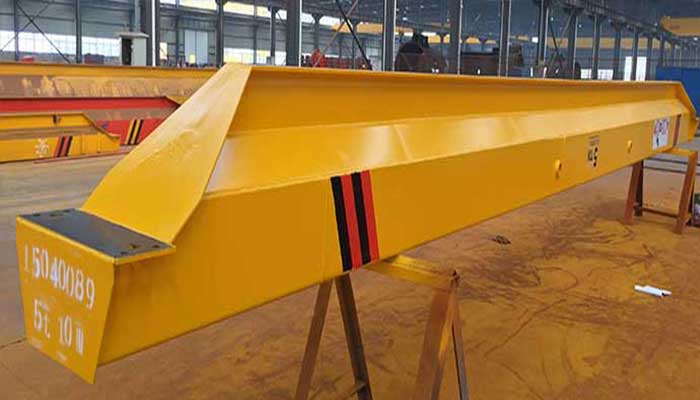
Overhead Crane & Gantry Crane Anti-corrosion Painting & Coating
Anti-corrosion coating & corrosion prevention is the most effective way to improve your corrosion resistance cranes work life and ensure safety. What are the anti-corrosion coating for your overhead crane, gantry crane, jib cranes and other outdoor cranes & cranes in corrosive application? Check now.
The main beam, end beam, and other important structure parts of an overhead crane are made of steel. Steel, the most commonly used material in overhead cranes, has the characteristics of high strength, good toughness, ease of processing, and low cost. However, its corrosion and rust resistance is poor when used in harsh environments or conditions, which may pose a risk to the structure's and overhead cranes' security. As a result, anticorrosion treatments for steel structures are extremely important.
Causes to steel corrosion
- The first step in resolving the rust problem of a steel structure is to understand the causes of steel corrosion. Corrosion of steel materials is caused by two factors in general.
- Steel corrosion mechanism at room temperature (below 100 °C)
- Steel corrosion is primarily electrochemical at room temperature, with the steel being corroded by the effects of moisture, oxygen, and other contaminants.
- The critical humidity of steel at room temperature is 60% 70%.
- Steel corrosion mechanism at high temperatures (above 100 °C)
Steel corrosion is primarily chemical corrosion at high temperatures. Under high temperature conditions, the steel and the dry air, such as O2, H2S, SO, and Cl2, etc., come into contact and produce the corresponding compound, such as chloride, sulfide, and oxide, which causes steel corrosion.
Steel structure corrosion prevention
The most common method is to coat the corrosion prevention layer to the steel surface, which is based on the electrochemical principle of steel corrosion. Corrosion prevention layers are classified into three types:
- Metal coating: A layer of metal is applied to the steel surface through electroplating, plating, electroless plating, hot dip, and other methods.
- Chemical protective layer: A layer of anti-corrosion chemical compound film is chemically or electrochemically coated on the surface of the steel.
- Non-metallic protective layer: To protect the steel, a layer of coating is coated on the surface of the steel by shelling-out and spraying, which is the most commonly used method.
Anticorrosive coating
At the moment, anticorrosive coating is the most commonly used method of protecting the steel surface. The anticorrosive coating is divided into three layers: the primer coat, the intermediate coat, and the finishing coat, each with its own set of features and functions. The three layers combine to form a composite coating that protects the steel from corrosion and extends its working life.
- Primer coat: Zinc rich primer and epoxy iron red primer are common primer coats that are coated by paint.
- ·Intermediate coat: Intermediate coat is painted by epoxy micaceous iron oxide and glass flake epoxy paint.
- Finishing coat: The finishing coat primarily employs epoxy paint, chlorinated rubber coat, and polyurethane coat.
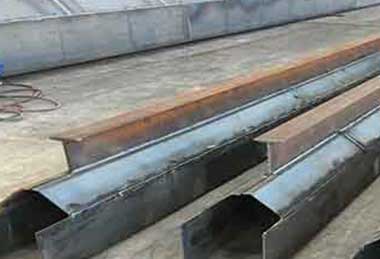
Crane girder without painting
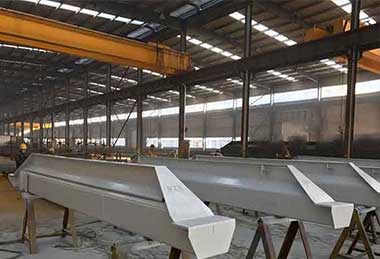
Primer coating of overhead crane
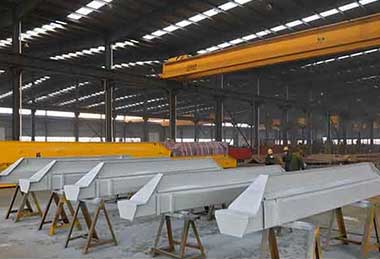
2nd layer of overhead crane
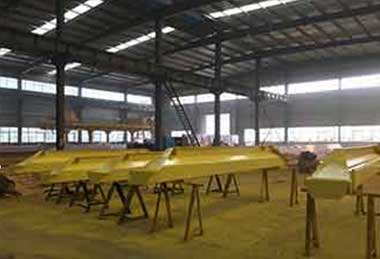
Top coating or finishing overhead crane coating
Anti-corrosive coating selection
How do you choose the right coating or paint when faced with a variety of options? For your convenience, here are some pointers:
- The application's climate and environment.
- The ease of construction conditions.
- The application of anticorrosive coating layers for correction.
- The cost, durability, and toxicity of the paint, etc.
Thickness of the coating
The thickness of the coating is also important when choosing the right coating. If the coating is too thin or uneven, it will have pinholes, from which the steel will corrode and become a rusty bulge, which will gradually expand and eventually drop off. If the coating is too thick, it may improve protection but reduces adhesion and mechanical properties and raises costs.
General coating thickness requirements
- When manual and powered dedusting is used, two primers and two fish coats are usually required for the components that have common coating requirements.
- When using jet blasting, it is preferable to paint the primer twice, the intermediate lacquer one to two times, and the finish coat twice for components with higher coating requirements.
- The total dry film coating thickness must be greater than 120m (weak erosion), 150m (moderate erosion), and 200m (heavy erosion) (an important component of a strong erosion). To achieve a good anti-corrosion effect, the thickness of the film should be even, continuous, and without pinholes.
Types of anti-corrosion coating & typical applications
Primers, intermediates, and final coats are the three primary categories of paint that we shall discuss in the following. Primers are used to moisten, cling to, and function as an inhibitor against corrosion on the substrate (the steel surface or underlying metal). Film thickness is increased by using intermediates. The final coat also provides surface resistance in addition to aesthetic value. It must serve as the first line of defense against weather and sunlight, open exposure, and moisture, depending on the exposure circumstances.
Additionally, there are four different categories of protective coatings for metal: barrier, inhibitive, sacrificial, and combination.
By preventing water, oxygen, and electrolytes from coming into touch with the underlying metal, barrier coatings shield metal from damage. Chemicals that prevent corrosion are present in inhibitive coatings. They respond to the anode, cathode, or other elements (oxygen, electrolyte, acid). Galvanic protection is offered by sacrificial coatings. To put it another way, they corrode (sacrifice) in place of the base metal, supplying electrons that turn anodes into cathodes and reverse the corrosion cell.
Two-Component Epoxy Coating for Bridge Crane Anticorrosion
Although there are various protective coatings available, epoxy coating is the preferred option in many crucial industrial coating applications. For heavy-duty application on metals like steel and iron, two-part epoxy coatings were developed, yet they consume less energy than heat-cured powder coatings. The epoxy is referred to as "two-part" because it is made up of a finish coat and a primer and is intended to shield metal substrates from corrosion and oxidation.
The epoxy coating is very durable and friction-resistant. Additionally, it offers the best defense against impact forces, corrosive substances, turbulence, heat, and cold. Diluted acids, alkalis, petroleum products, and condensation won't harm epoxy.
Cast steel and cast aluminum applications benefit most from two-component epoxy coat systems because of their low volatility, which mitigates exposure and flammability problems typically associated with solvent-borne coatings. Due to its heat resistance, epoxy is most frequently employed in industrial and automotive applications. Epoxy coatings may eventually lose their effectiveness due to UV exposure.
Typical use & application: Construction, manufacturing, power plant applications, machinery, pumps and compressors, farm equipment, and oil and gas pipelines are some of the major industrial applications.
Hot Dip Galvanizing for Overhead Crane Anticorrosion
Galvanized steel is reliable and very efficient if UV exposure is a key concern, if you are permanently placing a hoist and crane system near salt water, or if you need it for an extremely corrosive application. Steel is coated with zinc during the galvanizing process to prevent corrosion. Hot dip galvanizing offers speedy application both offsite and under controlled settings, as well as thick, long-lasting corrosion protection.
The fact that galvanized steel is produced utilizing naturally occurring zinc alloys is an additional advantage. When corrosion occurs, the zinc coating acts as a sacrificial anode and not the base metal. This corrosion supplies the electrons necessary to turn anodes into cathodes and reverse the corrosion cell.
Galvanized steel products are also totally recyclable and have a long lifespan. They offer resistance to abrasion, corrosive fluids, turbulence, heat, cold, and impact forces and are resilient and corrosion-resistant. Galvanized steel guarantees endurance in salt-water applications and corrosive environments and offers comprehensive covering.
Typical use & application: The following are some examples of important industrial uses such as pulp and paper mills, water treatment facilities, offshore platforms, pumps and compressors, farm machinery, oil and gas pipelines, marine applications, manufacturing applications, and off-shore platforms.
Powder Coating for Overhead Travelling Crane Anticorrosion
A dry powdered paint compound made of pigments, specialized resins, and fillers is applied during powder coating in order to create a painted finish. These components melt and fuse together during the curing process. A low-velocity air-powered spray gun is used to electrostatically charge the solid powder particles. This electrostatic charge attracts and holds paint particles to the substrate surface during the high temperature curing process. A solvent is required in conventional liquid paint to keep the binder and filler parts in liquid suspension. Powder coating utilizes electrostatically applied dry powder that is cured under heat to form a protective barrier around the metal substrate. The powder is typically used to create a tougher finish than traditional paint.
Although powder coating has a high impact resistance and can be quite pricey, it prevents chipping and scratches. It increases the lifespan of your overhead crane in caustic conditions and is most frequently utilized in situations that entail impact and particle abrasion.
Due to its availability in both standard and custom colors, powder coating does have the extra advantage of decorative variation. Additionally, it has different textures, such as smooth, wrinkled, matte, and rough. Powder coating systems are resistant to heat, corrosion, impact, abrasion, solvents, and most chemicals. Furthermore, they are resistant to sun and UV fading.
Due to the absence of volatile organic compounds (VOCs), which are pollutants present in the solvents used in liquid paint finishes, powder coating is environmentally friendly. They eliminate the need for users to purchase and maintain costly pollution control equipment, resulting in long-term cost savings.
Typical use & application: Automotive applications, construction, architectural applications, electrical applications, farm applications, everyday household applications, manufacturing, and machinery are examples of key industrial applications.
Learning more on crane anti-corrosion painting and anti-corrosion crane and corrosion resistance crane, please feel fre e to contact us.

